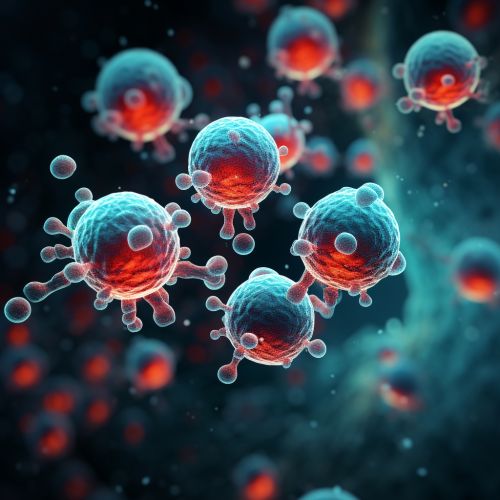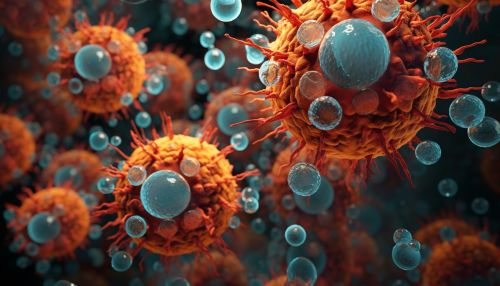B cell activation
Introduction
B cell activation is a critical step in the adaptive immune response. It involves the transformation of resting B cells into active, antibody-producing cells. This process is initiated when a B cell encounters its cognate antigen and is further modulated by signals from T cells and the microenvironment.
B Cell Structure and Function
B cells, also known as B lymphocytes, are a type of white blood cell that plays a central role in the humoral immune response. They are named for their development in the bone marrow, which distinguishes them from T lymphocytes that mature in the thymus.
B cells are unique in their ability to produce antibodies, also known as immunoglobulins, which are proteins that can specifically recognize and bind to antigens. Each B cell expresses a unique antibody on its surface, which serves as the B cell receptor (BCR) for antigen. The diversity of the BCR repertoire allows the immune system to respond to a wide range of pathogens.
B Cell Activation
B cell activation is a multi-step process that begins with the binding of antigen to the BCR. This triggers a series of intracellular signaling events that lead to the activation of the B cell.
Antigen Recognition
The first step in B cell activation is the recognition and binding of antigen by the BCR. This is a highly specific interaction, as each B cell is equipped with a unique BCR that can recognize a specific antigenic determinant, or epitope.
The binding of antigen to the BCR triggers a process known as receptor-mediated endocytosis, in which the BCR-antigen complex is internalized into the B cell. The antigen is then processed and presented on the cell surface in association with MHC class II molecules.
Co-stimulation
In addition to antigen recognition, B cell activation requires a second signal, or co-stimulation. This is typically provided by helper T cells, which recognize the antigen-MHC class II complex on the B cell surface and provide co-stimulatory signals through cell-cell interactions.
The interaction between the B cell and helper T cell is facilitated by several pairs of co-stimulatory molecules, including CD40 on the B cell and CD40L on the T cell. The engagement of CD40 by CD40L provides a critical signal for B cell activation and differentiation.
Intracellular Signaling
The binding of antigen to the BCR and the engagement of co-stimulatory molecules trigger a cascade of intracellular signaling events that lead to B cell activation. These signals are transduced through several signaling pathways, including the PI3K, MAPK, and NF-κB pathways.
These signaling pathways converge on the activation of transcription factors, such as NF-κB and AP-1, which induce the expression of genes involved in B cell activation and differentiation.
B Cell Differentiation
Following activation, B cells undergo a process of differentiation into effector cells. This involves several stages, including proliferation, class switch recombination, somatic hypermutation, and the formation of plasma cells and memory B cells.
Proliferation
Upon activation, B cells enter the cell cycle and begin to proliferate. This is driven by the expression of cell cycle regulators, such as cyclins and cyclin-dependent kinases, which are induced by signals from the BCR and co-stimulatory molecules.
Class Switch Recombination
During proliferation, B cells undergo a process known as class switch recombination (CSR). This is a DNA recombination event that changes the isotype of the antibody produced by the B cell, from IgM to another isotype such as IgG, IgA, or IgE. CSR is mediated by the enzyme activation-induced cytidine deaminase (AID) and is regulated by signals from the BCR and co-stimulatory molecules.
Somatic Hypermutation
In addition to CSR, B cells also undergo somatic hypermutation (SHM) during proliferation. This is a process of random mutation in the variable regions of the antibody genes, which can increase the affinity of the antibody for its antigen. Like CSR, SHM is mediated by AID and is regulated by signals from the BCR and co-stimulatory molecules.
Plasma Cells and Memory B Cells
Following CSR and SHM, B cells differentiate into plasma cells and memory B cells. Plasma cells are the main antibody-producing cells of the immune system, secreting large amounts of antibody into the circulation. Memory B cells, on the other hand, are long-lived cells that can rapidly respond to a subsequent encounter with the same antigen.
Conclusion
B cell activation is a complex process that involves multiple steps and signals. It is critical for the adaptive immune response, leading to the production of antibodies and the formation of memory B cells. Understanding the mechanisms of B cell activation can provide insights into the functioning of the immune system and the development of immune-related diseases.


